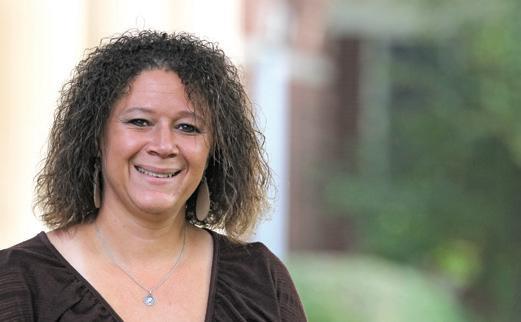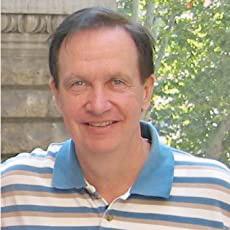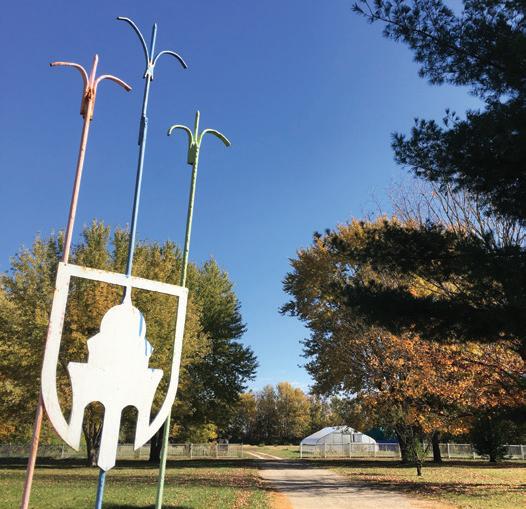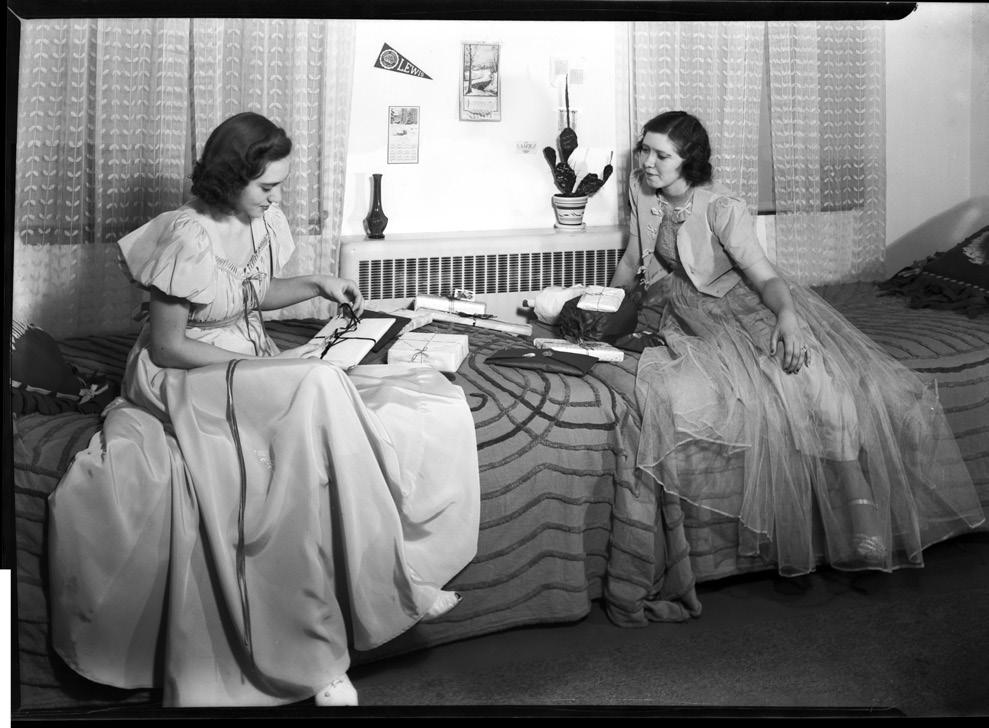
40 minute read
academics
ACADEMICS
POLITICAL SCIENCE IN ACTION
Advertisement
Fresh from the campaign trail, young Monmouth alumni reminisce about a memorable election year
By Barry McNamara
A half-dozen recent Monmouth College graduates had front-row seats to the craziness of the past “This is a celebrating Rep. Rita Hart,” said Steve Oaks ’16, who said he regretted the strategy of pulling back from election season, and some of them even found celebration of door-to-door campaigning during the pandemic. “But themselves in harm’s way as historic events unfolded. our students’ we wanted to be above it all. We wanted to be the safe
The six graduates took turns sharing their stories achievements. campaign.” in February during a Zoom event organized by the Monmouth College Tony Salgado ’20 worked a close campaign in College’s political science department. graduates can Georgia, where two special Senate run-off elections No one had a scarier time than Josh Perschall ’19, who was part of the team that helped Randy go out and work were held Jan. 5, with the balance of power in the U.S. Senate at stake. He was stationed in Atlanta Feenstra defeat incumbent Steve King in Iowa’s on anybody’s after working in Omaha during the run-up to the 4th Congressional District. Perschall is now part campaign.” presidential election. of Feenstra’s staff in Washington, D.C. It was only “It didn’t feel Midwestern-y at all,” he said of his fourth day on the job when the Capitol Hill insurrection Georgia. “I felt a little more intimidated there. A lot of the occurred on Jan. 6. Republicans I spoke to were dissatisfied. They didn’t feel a
“It was an absolutely horrible event,” said Perschall, who was push to get out and vote. I saw a spike in voter fatigue. I firmly in the Longworth Building, next door to the Cannon Building, believe Trump questioning the results of the election hurt the where a more serious breach occurred. “I’d only lived in Republicans’ chances there.” Washington for a week. It was very surreal. I was a little bit in “This is a celebration of our students’ achievements,” said fear for our safety, but there wasn’t any commotion on our floor. political science faculty member Robin Johnson ’80 while … We were holed up for six hours. We didn’t get to go home until introducing the event. “Monmouth College graduates can go out the National Guard showed up.” and work on anybody’s campaign.”
Alex Altamirano ’19 also recalled some tense moments going “The only reason I got into campaigning was because I took door-to-door in Kenosha, Wis., in Jacob Blake’s neighborhood. your class—that got the ball rolling for me,” Alex Cruz ’20 told On Aug. 23, 2020, Blake was shot seven times by Kenosha Johnson near the end of the Zoom session. Cruz worked for the police, an event that sparked outrage across the nation. Progressive Turnout Project, primarily contacting inconsistent
“I wouldn’t say it was fear, but I was at times concerned Democratic voters. because the tension was just so thick in Kenosha,” he said. “There Salgado’s takeaway from the 2020 election was that more was definitely animosity there. There was definitely tension subjectivity is needed. there.” “The only way to get better is to take away the reality TV
In the end, Altamirano and his co-workers were not able to tip part of politics—worrying less about ratings and more about Kenosha County’s vote in the Democrats’ favor. subjectivity,” he said.
It was an unusual year in politics and in the world, and Libby Altamirano spoke to that sentiment, and also about learning to Meyer ’15, who writes for the online site Iowa Starting Line, said take his lumps and to keep moving forward. maybe we should have seen that coming after the struggles by “Josh and I don’t usually agree, but it doesn’t influence Iowa Democrats to provide timely results of the February caucus. what I think of him as a person. We agree to disagree. … As
“Pete Buttigieg won by a hair, but The Associated Press for campaigning itself, you’ve got to be comfortable being actually never declared a winner,” said Meyer. “The struggles uncomfortable. You’ve got to learn to take the punches and roll with the new reporting app the Democratic Party developed was with them.” one of the first signs that 2020 was going awry. If only we knew Said Salgado: “Be empathetic to people, be patient. Knocking then that the whole year was going to go awry.” on doors is truly like a box of chocolates. You never know what
Iowa had another instance of a candidate winning by a hair, as you’re going to get.” Mariannette Miller-Meeks edged Rita Hart by just six votes out But, as Oaks said, being face-to-face sure beats a phone call— of nearly 400,000 votes cast in the 2nd Congressional District, one of two rules-of-thumb he said applies whether the subject is the narrowest margin of victory in a U.S. House race since 1984. the wild 2020 election, or one from previous years: “Yard signs
“Iowa would still be a Democratic state, and we’d be don’t vote, and nobody wants to talk to you on the telephone.”
ACADEMICS
Business, science students look to the future of solar energy
By Barry McNamara
ment was that solar power was only for the rich. Solar was 300
Tom Prince doesn’t claim to be Nos- times the cost, but now it’s the tradamus, but he’s pretty sure about cheapest because storage is so a prediction he’s made for the 2030s. much better. It’s easy to install, it’s
“We need to take stress off the (energy) user-friendly. Now, the estimates grid,” the Monmouth business professor are that in the next 10 or 20 years, told his students. “Looking 10 or 20 years we’ll see a meaningful percentage out, all I have to worry about is where the of people that can be taken off the fish are biting. It’s you guys who are going grid.” to have to deal with these changes.” Monmouth is an attractive Prince is spearhead- option to test Solar Inventions’ ing a project that has new panels because its Midwest recently kept select location provides some benefits. Monmouth science “When it gets really cold, when and business students there’s a snow load on the pan- determine how best to take their product occupied—monitor- els—those will be very interesting things to market. Working on that part of the Prince ing two cutting-edge solar panels mounted for us to track,” said Damiani. The College was also selected because project are Dominic DeCello ’21, Gavin Gard ’21 and Bryan Peters ’22. atop the College’s Center for Science and of a connection between Damiani and “We’re sitting here in a building called Business. Prince. the Center for Science and Business,” said
Last fall, those students heard from Ben “I’ve known Ben a long time,” said Prince. “Ben has created this wonderful Damiani, co-founder and chief scien- Prince, whose family became connected to science. What drives decisions are two tist for Atlanta-based Solar Inventions. Damiani when he tutored Prince’s daugh- things: management decisions and profit. The company won all three levels of the ter at Georgia Tech University. “We talked Management decides ‘Is it time for this inaugural American-Made Solar Prize about this kind of project this summer. He science to go public?’ This project with competition with its Configurable Current said, ‘I’ll get the panels to you.’” Solar Inventions is a way for them to Cell (C3) subcell technology, which allows Prince relayed that development to gather the right information to make the current to flow more directly by electrical- Monmouth physics professor Chris most informed decision.” ly dividing each cell into subcells. Fasano, who is also based in the Center If it is indeed time, there will be some
Solar Inventions split the first $1 million for Science and Business and has been major companies interested, said Prince. prize as part of a group of 20 and the next tracking results from a pair of solar panels “Both Ford and General Motors have $1 million in a group of 10, then split the for quite some time. committed to fully electric vehicles and final $1 million with another competitor, “These are cutting-edge solar panels,” production, which will include a heavy for a total of $650,000 in prize money. said Fasano of the eight panels, which demand on solar both for production and
Damiani told the students that solar each measure 66-by-40 inches. “We keep recharging,” he said. accounts for 1% of the current $1.4 trillion looking for ways for science and business Damiani said solar companies often global energy market. But as improve- to work together.” work with universities on research, but ments are made to solar energy storage, he Analyzing the pure data, which Fasano that the project with Monmouth “might predicted that solar power’s share of the believes will be positive, will be helpful to be the only one blending business and world market could rise to “30, 40, even Damiani and the College. science.” 50%.” “After we have some real data, we could “We are the only college or university in
Damiani said solar panels—which have show that solar really makes sense,” said the country with this particular technology become twice as efficient as they were Fasano. “We’d need at least a year’s worth in the panels,” said Prince. “Science and several years ago—have a lifespan of 25-30 of data. It wouldn’t be an emotional deci- business students are working together, years. sion. It would be a decision driven purely and we are planning a busy spring getting
“As efficiency has increased by two by the data we collect.” this set up and collecting data. It’s great for times, the price has dropped by 10 times,” Prince’s business students come into the school, and it’s an ongoing story. Tune he said. “Ten or 20 years ago, the argu- play as they will help Solar Inventions in for episode two.”
Damiani points out features of his C3 cell to students as they unload the solar panels in the Center for Science and Business.
ACADEMICS
A DOME FOR LEARNING By Duane Bonifer
a new monmouth college open-air
classroom is helping area school children better understand their environment while giving future teachers new ways to reach students.
Located on the Monmouth Educational Farm about four blocks east of campus, the open-air classroom was built last fall.
The 30-foot wide geodesic dome, on the edge of the nearly seven-acre working farm, hosted socially distanced projects this fall for nearly five dozen area grade school students who were part of the Warren County YMCA’s Y Academy program.
The classroom was built by members of the College’s educational studies department, with support from the Rural Schools Collaborative and a grant from Compeer Financial. The classroom’s purpose is to support the department’s efforts to promote place-based learning, which encourages teachers to incorporate students’ local geography into their lessons.
For Monmouth educational studies major Alex Johnson ’21, the socially distanced education events with area school children gave her a rare opportunity to practice place-based education.
“The Monmouth farm provided the YMCA students with an amazing learning opportunity, especially during a time when these experiences are hard to take place in schools due to the pandemic and all the restrictions that it brings into classrooms and schools,” said Johnson, who is also a member of the College’s TARTANS rural teacher corps.
“This opportunity and experience was so eye-opening for me as a TARTAN, since I have not yet been able to see place-based education taking place in person until now,” said Johnson. “The experience at the farm and working with the students really showed me just how much place-based education can impact students and their learning.”
During their visit to the College farm, the children worked on educational projects that had them hunting for insects and collecting leaves. Some of the children even discovered new foods.
Educational studies major Mariah Garzee ’22 said the field trips were a welcome respite from the sense of isolation that has been created by the COVID-19 pandemic.
“It made me happy to see the students so excited about looking for insects, and I think they were excited to just get to be outside for a little while,” said Garzee, who is also a member of the TARTANS rural teacher corps.
Seeing students’ interest in the activities inspired Garzee “to continue thinking about how I’m going to incorporate my future students’ place and the nature around them into their education.”
That was precisely why the open-air classroom was built, according to professor Craig Vivian, chair of the Monmouth educational studies department.
“This was a way to reach out to the community and get kids interested in the farm,” Vivian said. “I was also trying to find a way we could get kids to spend more time engaging in the cultural aspects of agriculture, and one of those is an appreciation of nature. I was so happy that every single kid was interested in what we were doing and what they could learn. What they reinforced, for me, was that this idea and vision for the farm and our program is good and has a place. It was very affirming and confirming.”
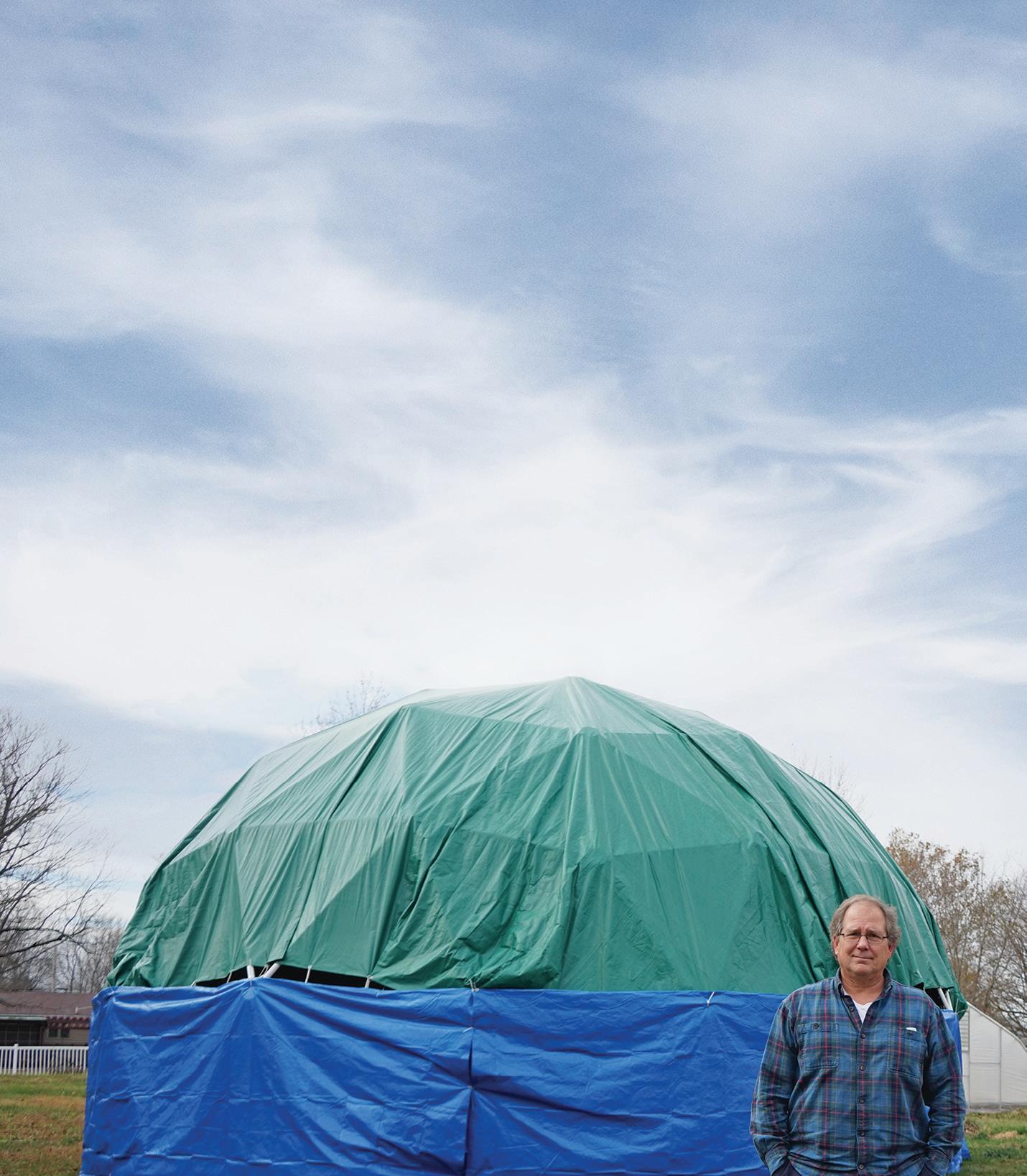
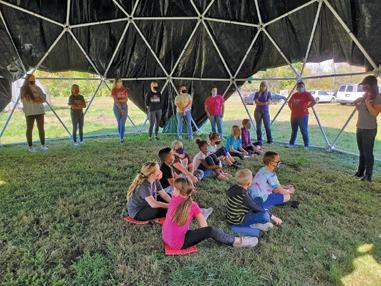
Y Academy students receive a lesson in the outdoor classroom. Professor Craig Vivian stands by the newly constructed dome classroom.
ACADEMICS
$600K grant funds study of student attitudes toward data science
Marjorie Bond, a Monmouth mathematics professor who specializes in statistics, is a member of a seven-researcher team that has received a $600,000 grant to better understand student attitudes toward learning about statistics and data science.
Funded by the National Science Foundation for Marjorie BondMotivational Attitudes in Statistics and Data Science Education Research, the project seeks to gauge motivational attitudes toward statistics in students and instructors, as well as understand environmental characteristics and other elements that influence student learning.
The research group expects that its results will be brought back to teacher education as best practices. Because data science—which Monmouth launched as an academic major in 2019—is a new field of study related to statistics, the group will produce the first instruments written to study that discipline.
Bond, who used her 2020 sabbatical to study data science, led a section of the College’s introductory data science course last fall and is doing so again during the spring semester.
“Data science education research is in its infancy with minimal research on attitudes and no validated measurement instruments,” Bond and her colleagues note in the proposal. “Quality instruments to measure student attitudes are priorities in both the statistics education and data science education communities.”
The three-year “Developing Validated Instruments to Measure Student/Faculty Attitudes in Undergraduate Statistics and Data Science Education” grant was written by Bond along with researchers from Villanova University, Winona (Minn.) State University, Mount Saint Vincent University in Canada and California State University, Monterey Bay. Working alongside the researchers are Bond’s faculty colleague at Monmouth, Wendine Bolon, and a professor from Elizabethtown (Pa.) College.
Bond said that work in Monmouth’s Summer Opportunity for Intellectual Activity program—known as SOFIA—allowed students to adapt the research tool Survey of Attitudes Towards Statistics (SATS) to study attitudes toward disciplines other than statistics. When the group’s results “didn’t make sense,” she realized they needed another instrument to measure attitudes toward statistics instead of the SATS.
“We saw similar patterns—no change in attitudes from precourse to post-course,” said Bond.“We were looking at other science disciplines like biology and psychology and were not seeing changes in attitudes. This didn’t make sense. It was at that point that I realized that the SATS wasn’t working.”
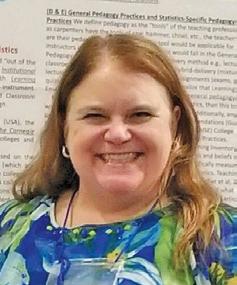
Globe-trotting Godde looking forward to another Fulbright
With a little luck at the end of this year, Monmouth biology professor James Godde will be able to continue a personal streak he began in 2006.
Godde has worked on an academic project outside of the United States every year since then, and he already has his foreign travel plans for 2022—thanks to a Fulbright U.S. Scholar grant he recently received to study at the University of Murcia in Spain.
The Core Fulbright U.S. Scholar Program sends about 800 U.S. scholars and professionals per year to about 130 countries, where they lecture and/or conduct research in a wide variety of academic and professional fields.
This will be Godde’s second Fulbright. The first one he received was in 2015 to study in the African nation of Mauritius. His international streak started by leading a Monmouth study-abroad trip to Japan in 2006, the year before he spent a sabbatical there.
Godde, who led students on a study-abroad project to Belize and Guatemala before the pandemic hit last year, hopes to lead another student trip to El Salvador during Christmas break at the end of this year. During his sabbatical next spring, Godde will study the evolution of histone-like proteins in bacteria. James Godde
ACADEMICS
Anne Mamary GUTIERREZ ROMANO CANTERBURY RODEFFER EVANS MARTINO MORENO AYUSO OLUSOGA
SCHOLARSHIP COMPETITION DRAWS EIGHT GIFTED CANDIDATES
Eight high school seniors make up the top scholars in Monmouth College’s Class of 2025. The students were chosen from a group of 165 high school seniors from 15 states who competed in early 2021 for the top three scholarships awarded to incoming freshmen, 30 students more than for any of the past three years.
Two students were named William J. and Beverly Goldsborough Scholars, a four-year, full-tuition scholarship available to students from the Chicagoland area: Michelle Gutierrez of Chicago, who plans to major in biology to prepare for medical school; and Emma Romano of Wilmington, Ill., who plans to major in business administration and music.
Two students were named Admiral’s Scholars, a fouryear, full-tuition scholarship plus a $5,000 academic enrichment fund and a place in the James and Sybil Stockdale Fellows Program leadership program: Emily Canterbury of Orion, Illinois, who plans to major in either English or neuroscience; and Ilese Rodeffer of Bushnell, Illinois, who plans to major in psychology to prepare for medical school.
Four students were name Trustees’ Scholars, an annual $30,000 scholarship: Bailey Evans of Indianapolis, who plans to major in English; Mia Martino of Palatine, Illinois, who plans to major in history; Christian Moreno Ayuso of Chicago, who plans to major in mathematics; and Damilare Olusoga of Chicago, who plans to major in biochemistry.
Pursuing philosophy through alchemy and Harry Potter
Monmouth philosophy professor Anne Mamary has been a huge fan of the Harry Potter series for two decades, so much so that she even teaches a course called “Harry Potter and the Philosopher’s Soul.”
Mamary now has another text that she can use for the class, a book she edited titled The Alchemical Harry Potter: Essays on Transfiguration in J.K. Rowling’s Novels, now available through McFarland Publishing.
Mamary also authored the book’s final essay, “Ruddy Stargazers: Centaurs, Philosophers, and a Life Worth Living.” A pair of 2018 Monmouth graduates, Isaac Willis and Sean Paulsgrove, have essays in the book, titled, respectively, “Re-Reading Harry Potter, Re-Creating Ourselves” and “Tapping on Just Another Brick in the Wall.” Middle school teacher Tamy Rankin ’81 wrote the introduction to one of the book’s three sections.
Mamary’s attachment to the series, which debuted in 1997, took a while to develop. She was in her 30s when she read the first three books of the series, simply because “I wanted to see what all the fuss was about. By the time the fourth book came out, I was in line at Barnes & Noble at midnight to get it with all these students wearing Hogwarts costumes.” Although many books have been written about the Harry Potter series, Mamary’s book has a unique angle, based on Rowling’s personal interest in alchemy, which provided the internal logic for the series.
Alchemy is an ancient branch of natural philosophy. Modern discussions of it are generally split into an examination of its exoteric practical applications and its esoteric spiritual aspects.
Mamary, who studied chemistry in college, now wishes Rowling’s books had been available when she was growing up and that perhaps they would have steered her toward studying alchemy.
“But alchemy is not about money or eternal life,” said Mamary. “It is much more about the transformations of desire, of power and of people—through love. Harry’s equally remarkable and ordinary power to love leads to his desire to find but not use the Philosopher’s Stone at the start of the series and his wish to end the destructive power of the Elder Wand at the end.”
The collection of essays on alchemical symbolism and transformations in Rowling’s series demonstrates how Harry’s work with magical objects, people and creatures transfigure desire, power and identity.
UPDATE: COPING WITH COVID
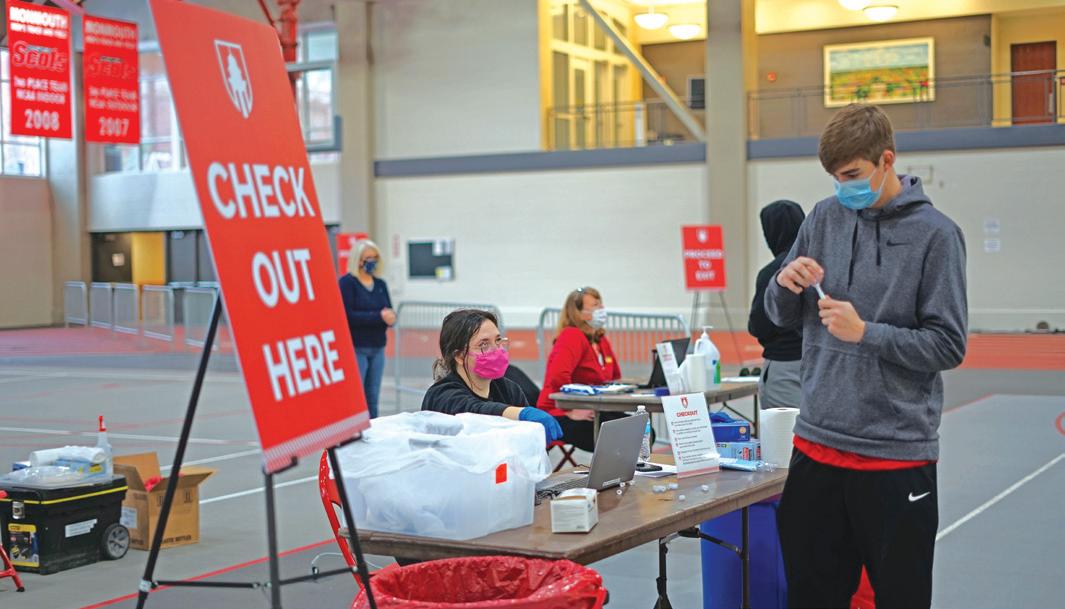
Saliva-based testing allowed campus to open safely
Monmouth College’s spring semester opened on schedule in January, but not before all in-person students, faculty and staff had been tested for covid-19, using an innovative saliva-based test developed by the University of Illinois.
The College received a $150,000 grant from the Community Health Foundation of Warren and Henderson Counties to purchase 5,000 SHIELD Illinois tests, which are being administered not only to the campus community but also to any residents of Warren or Henderson counties.
The highly accurate test, which has obtained federal emergency use authorization, gained national attention by allowing the University of Illinois’ three campuses to remain open for in-person learning since last fall, with more than 1.5 million samples collected to date.
At accuracy levels of 99.8-99.9%, with very few false positives, the test matches the accuracy of more invasive and expensive tests. It has been praised for its simplicity, without the need for administration by medical professionals. Monitored by trained observers, participants fill a test tube with their saliva, and receive results on a phone app within 12–24 hours.
“From the beginning of this pandemic, Monmouth College faculty, staff and students have pursued the twin goals of safeguarding each other’s health and delivering our educational experience as effectively as possible,” said President Clarence R. Wyatt. “In the current climate of covid-19, Monmouth College also realizes our duty to the city of Monmouth and to Warren County to do our part in the mitigation of the virus.”
Community-wide testing is being offered to the public two days per week in the Haldeman-Thiessen Center. The College is also administering surveillance testing of the campus community periodically throughout the semester.
“Providing rapid results in the case of a positive test for students or employees will allow Monmouth College to take swift action to reduce the spread of the virus,” Wyatt said. “We hope to identify infected individuals early and save lives by curbing the spread of covid-19, while reducing productivity loss and prioritizing the well-being of our students, employees and members of the Monmouth-Warren County community as a whole.”
Spearheading the implementation of the program on campus were psychology professor Joan Wertz, executive assistant to the president Amy Warrington and chief information officer Nick Carlson ’08. Megan Davis ’21 served as student coordinator.
Prior to the opening of spring semester, COVID testing was performed in the fieldhouse of Huff Athletic Center to allow ample room for social distancing.
SCOTS CARE: Student initiative delivers financial support during pandemic
Monmouth College’s student government has continued a campus-wide tradition of “looking out for each other,” raising more than $23,000 for students in need through its Scots Care initiative.
“During the pandemic, we realized that there is a lot of financial strain on students,” said Abierre Minor ’21, president of Scots Student Senate. “Even if we think about the stimulus and other federal programs, students cannot qualify for that, so we recognized that students were really at a vulnerable state. We wanted to create a fund that can help with that and bring some financial security to the students on campus.”
Scots Care is available to all Monmouth students. The emergency fund helps subsidize items such as travel expenses, books, laundry, food and other needs. Anybody can apply to receive the funds, said Minor.
“Originally, we were reaching for the stars,” she said of a financial goal. “We hoped the fund would reach a figure like it has. We were OK with a lower figure, but to get to something like $23,000 and counting is really beautiful. It’s a testament to the community strength right now. We’re a community-oriented school. We look out for each other and we take each other seriously. We’re a tight-knit group.”
Minor said one of the incentives for creating Scots Care was the story of a particular student
—abierre minor ’21
who is no longer at Monmouth— an international student who had received a full scholarship from his country to attend Monmouth and was fully engaged as a student, who then lost his funding because of the pandemic.
“That’s when we really came to the table as Scots Student Senate and said, ‘We really need to do something about this,’” she said. “I think the purpose of student government is to serve students and to tap into the needs of the community. Of course, we can’t fund full tuition. If we could, we would. But we need to do something to help some of these students. That’s what started the
Kaitlyn Fisher ’22 and Cullen Marshall ’22 in a recent production of Rajiv Joseph’s Gruesome Playground Injuries.
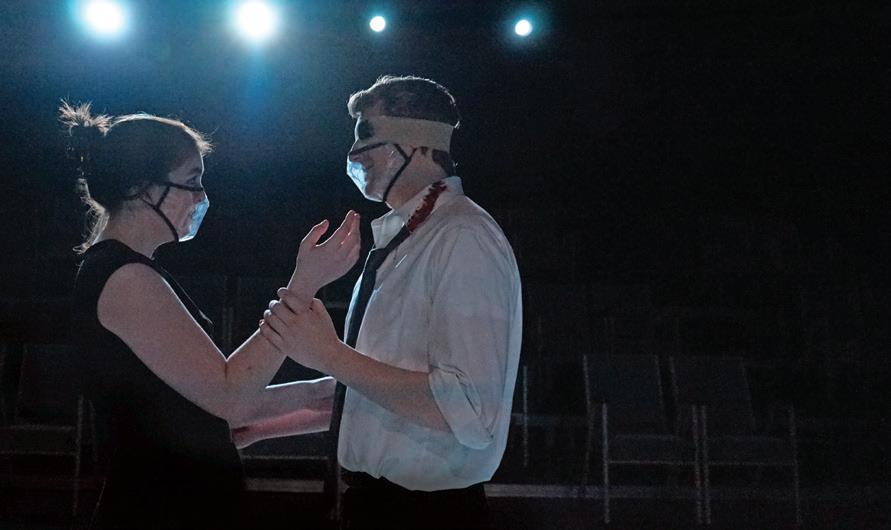
THE SHOW MUST GO ON
Masks were an integral part of ancient Greek theatre, but it wasn’t until the pandemic that they once again became a staple. Monmouth’s theatre department has successfully presented two masked productions with limited casts and the option for purchasing a live stream rather than attending in person.
ball rolling for Scots Care. We are so blessed to have people contributing to the fund. It’s going to impact and enrich so many lives.”
Scots Care is a way to reach out to students during a time when opportunities to physically reach out have been limited, providing some of the compassion and empathy that can’t be shown in person.
“One of the things that this pandemic has taken away from us is that interaction with each other and a lot of the physical community building that we do,” said Minor. “Within my friend group, when we’d see each other on the sidewalk, we’d hug. We’ve all missed a little bit of the hugs, the physical encouragement that you get on campus. Even just people waving at you or talking to you randomly.”
When the pandemic first became an issue last spring, Monmouth students were sent home for the rest of the semester. They returned to campus last fall, but with many social distancing requirements and other covid-19 protocols.
“Unfortunately, because we have to social distance, we have to go back into ourselves and keep our friend groups small,” said Minor. “I think a lot of students miss that community base—being able to speak to whoever and hang out with whoever, whenever. We’re missing that engagement. I miss meeting new people on campus. On this campus, you almost make a new friend every day or every week. That’s what we signed up for.”
—Barry McNamara
An extraordinary first year
A year ago, they were among more than 100 students from the Midwest competing for one of the top scholarships at Monmouth College. This school year, they are among the distinguished members of Monmouth’s Class of 2024, and some of them have experienced an extraordinary first year at Monmouth.
Luis Castillo ’24 said that despite the strange arrangements because of the pandemic, he’s been impressed by what the Monmouth professors have done to make the 2020–21 school year a memorable one. “The professors are still there to care for you and show you that even though we’re going through tough times right now, they’re still there for you,” said Castillo, a neuroscience major. “That just stands out even more to me because the professors are not only there to teach you but they’re also there for you if you need anything, and that is regardless if a professor is within your major or not.”
Janice Abel ’24, an English and public relations major, said she knows that the 2020–21 school year has been unusual, but she doesn’t have anything to measure against it because this is her first year of college. “I wouldn’t know how college is without the pandemic because that’s just how it’s been while I’ve been in college,” said Abel. “It’s definitely been weird not being able to go to events or attend events that have all of these restrictions.”
In September, Abel participated in the Theatre Department’s annual FusionFest, a 24-hour theatre festival. “We had to be six feet apart when blocking and the audience had to be six feet apart,” she said. “It was definitely an odd experience, but I enjoyed it a lot.”
Tyler Houck ’24 also said he doesn’t know what he’s missing out on because of the pandemic. But the accounting and business major said he’s enjoying his first year on campus as a Monmouth Scot, which also includes being a member of the baseball team. “I just appreciated that we were on campus in the first place and being able to live in the dorms and have a roommate,” said Houck. “We’ve even been able to do some stuff with the baseball team, such as get in practices by wearing masks and all that. So I think it can only get better from here, and I already am enjoying it. So that’s a good sign.”
Pandemic inspired psych majors to conduct COVID-19 research
The COVID-19 pandemic affected college students in numerous ways during the fall 2020 semester. For three Monmouth psychology seniors, it presented research opportunities.
Alison Bowman, Abigail BOWMAN Haslem and Abby Tucker switched the research topics of their senior capstone project and connected them to the pandemic.
“I’ve been curious about how covid has impact- HASLEM ed everyone’s lives,” said Haslem while presenting her final project, titled “Perceptions of covid-19 and Their Effects on Mental Well-Being and Social Support.”
“Social distancing has TUCKER caused social isolation, which correlates with stress, anxiety and depression,” she said. “Quarantining can lead to depression and PTSD (post-traumatic stress disorder). ... People have become more fearful of infection and death.”
For her project, Haslem interviewed 138 participants, primarily college students. Thirteen percent of the people she surveyed reported that they have delayed their graduation.
“Academic performance has declined as stress leads to lower grades, neglecting responsibilities and increased irritability,” she said. “A lack of social support contributes to psychological distress, which can be just as harmful to an individual as smoking, obesity or high blood pressure. People gain emotional sustenance from their social groups, the people who are going through similar life experiences.” Tucker studied the “Big Five” personality traits— agreeableness, conscientiousness, openness, extroversion and neuroticism—for her project, titled “Personality Types & covid-19 Behavioral Tendencies.” She worked with a test group of 224 participants. Those falling into the category of neuroticism were much more likely to have behaviors such as washing hands and avoiding gatherings, bars and restaurants. “They showed a fear of the virus and a tendency toward protection of oneself,” Tucker said, while extroverts did not tend to avoid gatherings, due to being outgoing and seeking social interaction.
“Any additional knowledge about slowing the spread of covid-19 is a step in the right direction,” she said of all three projects. “Health officials can utilize this information.”
Bowman studied the relationship between the personality types also examined by Tucker and alcohol use as a reaction to covid-19, focusing on neuroticism and extroversion.
In her study of 120 participants, she found a correlation with the way neurotic personality types behaved.
“Those with a neurotic personality type drank significantly less before covid” she said. “That was in alignment with my hypothesis. Extroverts drank consistently, so there was not as much of a correlation.”
IN MEMORIAM
Suda put the ‘human’ into humanities
David Suda, a Monmouth College professor widely acclaimed by his colleagues and former students as a “Renaissance man,” died Feb. 27 at the age of 77 at his Sarasota, Fla., home.
Suda officially taught in the College’s department of history, but he was listed in the course catalog as a professor of humanities, also teaching courses in philosophy, religious studies, art and music. A skilled musician, Suda was concertmaster of the Knox-Galesburg Symphony and the violinist in the Knox-Galesburg Symphony Trio, playing alongside his wife, Monmouth music instructor Carolyn Suda, and the symphony’s conductor, Bruce Polay.
In thanking Suda for his 23 years as concertmaster of the Knox-Galesburg Symphony, Polay wrote, “From my view, David Suda has always been an exceptionally intelligent, wellschooled advocate for bringing great music to life.”
Suda joined Monmouth’s faculty in 1984 and taught for 27 years. One of his initial tasks was to help redesign Monmouth’s liberal arts curriculum, and one of the lasting elements of that effort was the College’s honors program, which he coordinated for several years.
“To me, he was the brightest, best-educated and most wellread person I ever knew, and I’ve been around higher education all my life,” said Monmouth emeritus professor of English Jeremy McNamara, who for several years walked five days a week with Suda. “And then my other interest is music, and David was spectacular at that, too. He was a great person to be around in all ways.”
Another one of his former colleagues at Monmouth, music professor Ian Moschenross, shared a similar sentiment about Suda.
“I have never known anyone like David—professional violinist, imposing intellectual, beautiful writer, military veteran, dear friend,” said Moschenross. “David and Carolyn introduced me to a world of great literature which we never tired of discussing, often very late into the night. David believed in the indispensability of culture, of art, and of empathy. His students loved him and remember his courses.”
Melissa Scholes Young ’97, one of his former students, took her first class with Suda by mistake thanks to an error with the room number.
“Dr. Suda strode in and read Anna Akhmatova,” she recalled. “It was ‘He Loved Three Things Alone …’ which he read first in Russian. It was a performance—as good teaching often is. The class was ‘Russian Cultural History,’ and I wasn’t supposed to be in it. But I was smitten with the words and Dr. Suda’s passion for them. I declared history my major because I wanted to keep coming to any class with him.”
Young went on to be a professor and author, and Suda has been there with her every step of the way, from the lessons he taught her at Monmouth—including learning how to think—to the help he’s provided with her manuscripts.
“Dr. Suda believed that history, language, music and love would teach us how to live,” she said. “He challenged us to consider how to live our lives backward with intention rather than blindly moving through the decades.”
When Young began writing her own stories, a decade after graduating from Monmouth, she sent them first to Suda.
“He wrote me long letters back and gave me reading lists,” she said. “He was always present and generous with his time. We were pen pals Suda with Scholes Young ’97 in 2017.for years and my mentor became a friend. He asked me to call him David. I still can’t. We compared stories of raising daughters. He sent me updates of his beloved (daughter) Anne and shared pictures of the cats adoring Carolyn.”
In short, said Young, Suda provided her a great gift: “He saw value in my mind, so I learned to do the same.”
“For me, Dr. Suda was the epitome of what it meant to be a professor,” said the Rev. John Huxtable ’04, pastor of First Christian Church in Virden, Ill. “Throughout the many courses that I took with Dr. Suda, I was taught much more than simple academics; he taught us how to be better people in the world. He opened our eyes to see with new lenses that included compassion and grace in all our decisions, and sought to help us see everything that our decisions would impact.”
Suda coupled his almost incomparable intelligence with a humanity that made him approachable for the students he was trying to marshal through their time at Monmouth, and beyond.
“There was a wonderfully noble nature that he carried himself with that resonated from him as he taught or was simply in conversation with you,” said Huxtable. “He was filled with this
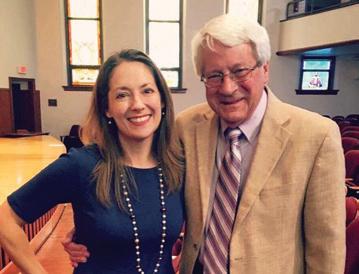
—Professor Emeritus Jeremy McNamara
amazing grace for his students and was always willing to listen to you when you needed to be heard. He cared deeply for each of his students, and he shepherded us through his courses with a wonderful grace that is very rare. He was also tough, which made you appreciate the finality and the accomplishment of completing the course.”
Although he retired from the full faculty in 2011, Suda was still a presence on campus, teaching violin to talented musicians such as Syrian refugee Mariela Shaker ’15 and current student Holly Reyner ’21.
“David always had amazing stories and he had a special way of making people want to give absolutely everything they had,” said Reyner. “For music to truly be an art, you have to put yourself into it, and he knew exactly how to get people to do just that. David was one of the most intelligent people I have ever met. Every lesson with him was not only a music lesson, but also a life lesson. He was always inspiring and spirited. He was truly an incredible person.”
To Shaker, Suda was more than just a teacher.
“I am blessed to have had the opportunity to be a student of a profound, humble and intelligent man,” she said. “I still remember the first violin lesson with David in 2013 as if it were yesterday. He worked with me so much to become a better violinist and human. David was not just my beloved violin teacher, but also my American father. I came to the U.S. as a stranger and vulnerable, with no family or friends. Soon afterward, David became my new family. How many Thanksgiving dinners, Easter breaks and holidays we celebrated together.”
Suda earned his bachelor’s and master’s degrees in his native state at the University of South Florida and his Ph.D. from Emory University in Atlanta, where he was concertmaster of the Opera Orchestra of Atlanta and the Atlanta Ballet Orchestra and was a member of the Georgia State University Faculty String Quartet and the Emory Piano Trio.
Suda’s book, The Moving Image, published in 1989, is a study of the idea of time as symbolized in clocks. Books on his reading table at the time of his death included Richard Holloway’s Stories We Tell Ourselves, Celtic Daily Prayer and Anton Chekhov’s Sakhalin Island.
“Dr. Suda was a treasure to Monmouth College, as well as the world, and he will be dearly missed,” said Huxtable. “It is not hyperbole to state that without Dr. Suda and his influence I would not be the man I am today.”
Said Moschenross: “More than anything else, David helped me better to understand the connections among art, music, theatre, history, politics, theology, philosophy, and on. I think this is what he shared with his students as well. He was deeply committed to the study of the human condition and his contribution to the intellectual life of Monmouth College will leave a lasting imprint.”
Shaker said her “American father” will live on.
“In my violin case, I keep my photo with David from my Monmouth College graduation, so every time I play, I feel that Professor David is there with me listening. David is not dead. He will always be alive in my heart and memory. I shall never forget you, my American father, and I love you so much.”
Carolyn Suda snapped this photo of the diverse reading materials next to where her husband was resting the day he died. “This is exactly how I found his table,” she said.
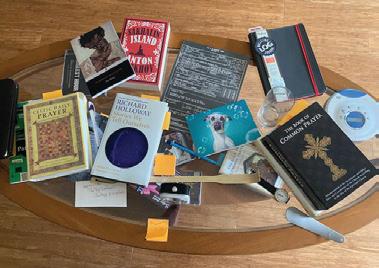
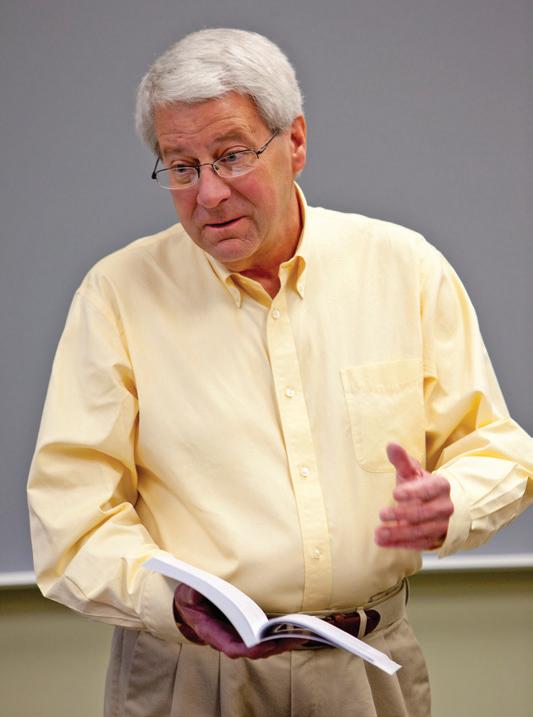
—Barry McNamara
Capital Campaign tops $61 million
onmouth College’s Light This Candle Campaign has reached an impressive milestone, climbing past the $61 million mark with almost two years remaining.
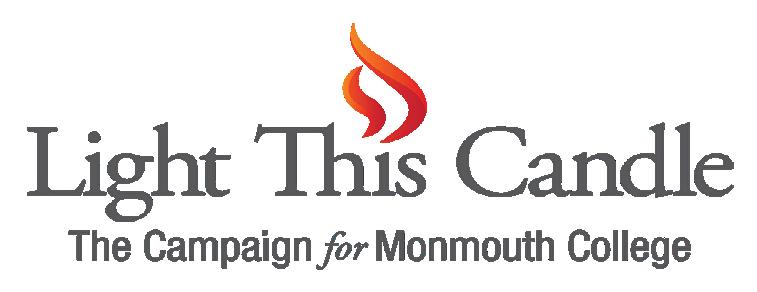
By Barry McNamara
education with greater confidence and to The Campaign, which formally kicked build the College not just for the present off in March 2019, aims to raise a moment, but for generations to come.”minimum of $75 million by Dec. 31, 2022. The Campaign, which stood at Light This Candle will significantly $61,052,770 million on March 1, was bolster Monmouth’s endowment bolstered by a “nice array of donors” in while focusing on four terms of the dollar amount of the gifts objectives: increasing financial aid and scholarships available to students; creating more opportunities for faculty and staff support and academic innovation; adding to a capital improvements fund that supports campus infrastructure; and creating a stronger financial base for the College by building an even stronger culture of philanthropy. “The College’s mission statement proudly asserts that ‘we empower students to realize their full potential, live meaningful lives, pursue successful careers, and shape their communities and world through “The progress of the Light This Candle Campaign is a result of the deep belief in that mission held by so many people.” —President Clarence R. Wyatt and the type of contributions made, according to Monmouth Vice President for Development and College Relations Hannah Maher. “We’re moving forward successfully despite this being a time when we’ve all been a little unsettled due to the pandemic,” said Maher. “We’re seeing that people still want to give to the institution, and they’re not as hesitant as I might’ve thought. They’re supporting all our different candles and are especially stepping up by funding student scholarships and support, keeping our students at the forefront of the Campaign.” service and leadership.’ The progress of the Light This Candle Campaign is a result of the deep belief in that mission held by so many people,” said President Clarence R. Wyatt. “Their generosity enables the College to navigate the challenges confronting all of American higher The Johnsons
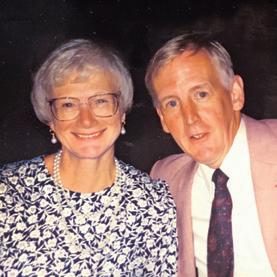
Now, instead of later
Among the donors who have participated in the Light This Candle Campaign are Bob ’59 and Marilyn Schneider Johnson ’59 of Oxford, Ohio, who met as Monmouth students and are grateful for the education they received.
“When the pandemic started, we had just updated our will and designated a gift for Monmouth College,” said Bob. “We never got around to telling anyone (at the College) about that. But then we received the (Monmouth College Magazine) donor issue, and right around the same time, we got an email about gift annuities from (Director of Development and Legacy Giving) Gena Alcorn.” With that information about gift annuities, Marilyn said of a gift to Monmouth, “Why don’t we do it now instead of later?” That “instead of” became “in addition to,” as the Johnsons worked with Monmouth development officer Bobbi Pio to make a stock gift in addition to setting up a scholarship with their estate.
“Bobbi made it very easy for us,” said Bob. “We transferred the stock and got it all set up. Instead of receiving a stock dividend, we get an income from the gift annuity. Marilyn and I both had such a positive experience at Monmouth, and this allows us to do something good for the College right now.”
Capital Campaign tops $61 million
Supporting rural America
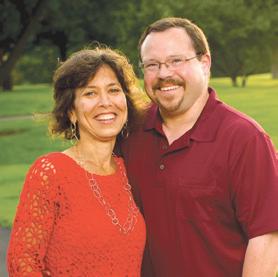
“The national situation is such that Roger Ray ’53 of Lacey, Wash., is we have to fall back on strong programs establishing a scholarship that will in the sciences and believe in them and support students from small towns who support them,” he said. study science. Ray came to Monmouth from Abingdon, Ill., a few years after war heroes (and cousins) James Stockdale ’46 and Bobby Dunlap ’42 also came to Monmouth from Abingdon, which today has a “It’s important to me to population of support students who around 3,500. come from a non-college “When I family background, and took calculus students who come from small schools and small towns.” my freshman year, I was the only one out of —Roger Ray ’53 16 students who hadn’t had precalculus in high school,” said Ray, who makes annual gifts to his alma mater. “So it’s important to me to support students who come from a non-college family background, and students who come from small schools and small towns.” Ray said such students flourish at Monmouth. “I want students to take advantage of what’s offered at a school like Linda Groves
Monmouth, which gives you a good, broad background,” he said. “It’s not so much about what you study, it’s about learning how to learn—that continued learning that is so important today.” Ray studied chemistry during its
Haldeman-Thiessen heyday on campus, so he’s particularly partial to supporting students pursuing what today is called
STEM (science, technology, engineering and mathematics). Part of the community
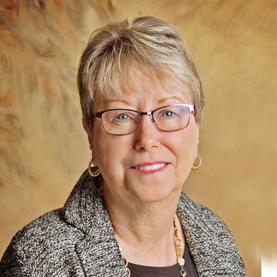
Another donor who established a scholarship during the campaign is Linda Groves of Galesburg, Ill., who was married to the late Rob Groves ’65. Although she is not a Monmouth graduate, Groves has always been mindful of what the College means to the town where she was born and raised.
“Monmouth College had always been a part of the Monmouth community,” she said, thinking back to her youth of theatre performances and a variety of cultural events held in what is now called Dahl Chapel. “The College gives people an opportunity to express themselves, and for others to see all those types of genres expressed.” Groves also fondly recalled Monmouth students going into the community in the 1960s and serving as tutors through a program at Jamieson Community Center. “I absolutely love Monmouth College, and even though I’m not a graduate of Monmouth, I still felt the need for supporting students,” said Groves, who created the Robert & Linda Groves Scholarship through a gift she’ll fulfill over the next five years. The only criteria of the scholarship are to be a Warren County resident with financial need.
“Education is expensive—we all know that,” she said. “There are so many people who want to go to college but can’t afford it. So we need to support that. If we don’t do it, who will?” Creative giving
Brad Nahrstadt ’89 and his wife, Debra, considered making a gift to support a scholarship, but then decided to get “creative” with their campaign contribution.
“There was no question that Deb and I were going to support the Campaign,” said Nahrstadt, who is a member of the Monmouth College Board of Trustees. “I made my first gift to Monmouth when I was still a senior in college, signing over my room deposit to go toward the Class of 1989 gift. I realized from the word ‘Go’ how important it was to support The Nahrstadts Monmouth. I call it the debt I’ll never fully be able to repay.”
Nahrstadt said he owes that debt, in part, to others who came before him and donated to campaigns before Light This Candle.
“I received a Senate Scholarship to attend Monmouth, which covered about half of my expenses,” he said. “But then there were other scholarships I received that helped me stay at Monmouth. I benefited from someone else’s largesse.”
The students who will benefit from the newly created Nahrstadt Mentorship Fund are Monmouth’s Lead Mentors.
“I’m really passionate about the student experience at Monmouth,” said Nahrstadt, who chairs the Board’s Student Affairs Committee. “There’s never been a consistent source of funding for the mentoring program. So when Deb and I were looking for a more out-of-the-box type gift, this was suggested as a possible avenue, and we both said, ‘Now we’re talking.’ This will be an opportunity for us to really see our dollars put to good use and help multiple students in their mentoring role.”

